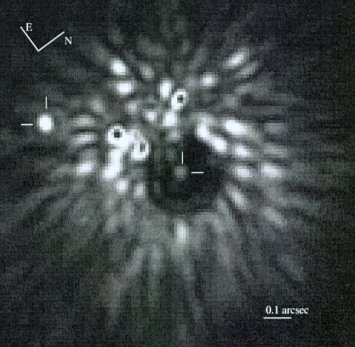
 |
Chi-1 Orionis, the solar-type naked-eye star, is hidden at the center (its position indicated by the cross-marks) behind a dark "occulting disk" in the telescope so that it will not overwhelm the tiny, dim companion, which is indicated by the cross-marks to the left. The spots surrounding the bright component are optical artifacts. Chi-1 Ori B averages roughly Jupiter's distance from the Sun from much brighter Chi-1 Ori A. From "Direct Detection of the Companion of Chi-1 Orionis" by B. Koenig, K. Fuhrmann, R. Neuhaeuser, D. Charbonneau, and R. Jayawardhana in Astronomy and Astrophysics, vol. 394, L43, 2002. |